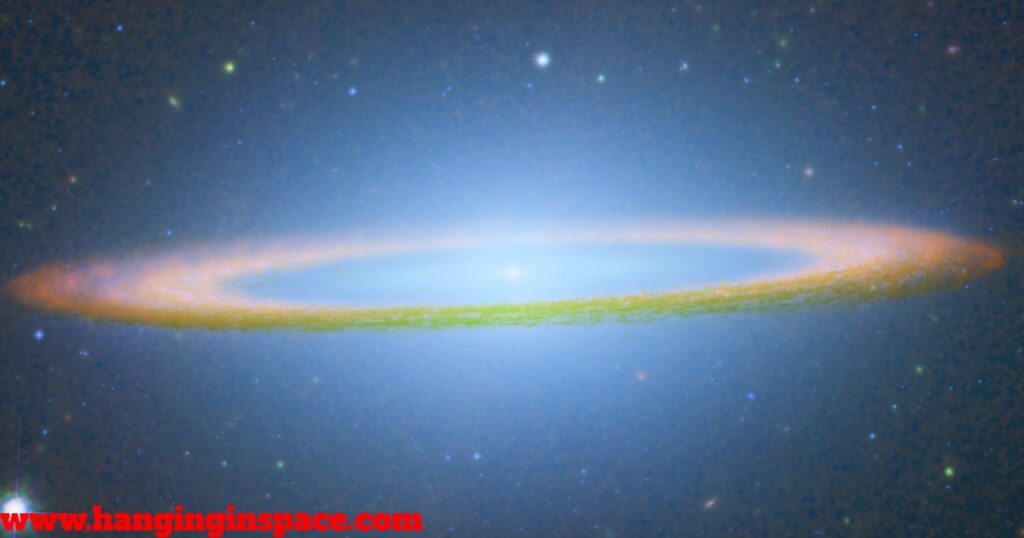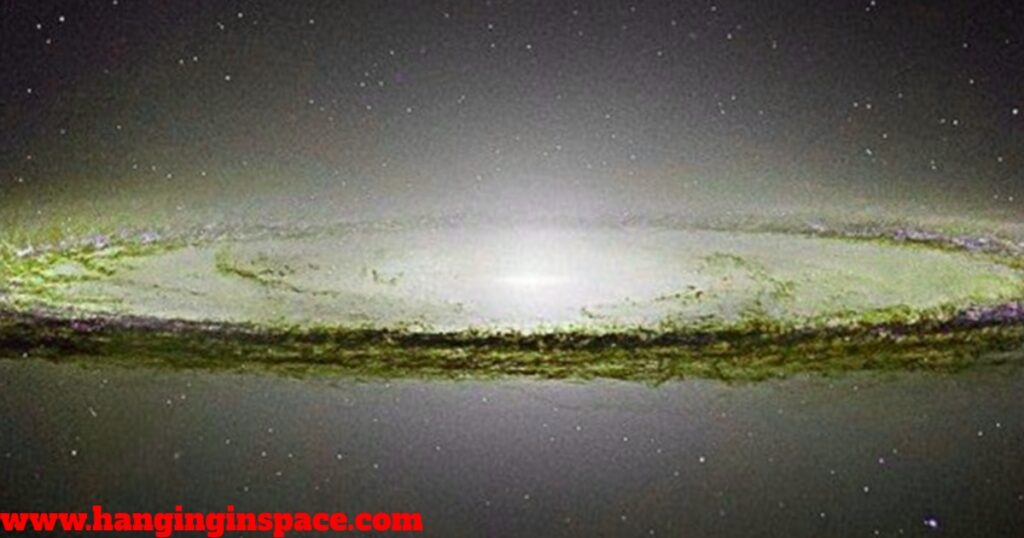The Sombrero Galaxy is a galaxy located at the constellation boundaries of Corvus and Virgo, around 9.55 megaparsecs from our Milky Way galaxy.
It is part of the Virgo II Groups, which are a collection of galaxies and galaxy clusters that extend from the Virgo Supercluster’s southern boundary. The Sombrero Galaxy is also known as also known as NGC 4594, M104, or Messier 104.

The radius of the Sombrero Galaxy is around 25,000 light-years and its distance from Earth is around 28 million light-years. This spiral galaxy presents itself to us in a nearly edge-on view. This perspective is what creates its signature sombrero-like shape, with a bright, central bulge encircled by a prominent dust lane that resembles the wide brim of a hat.
When and Who Discovered the Sombrero Galaxy?
The Sombrero Galaxy was discovered in 1781 by French astronomer Pierre Méchain. The Hubble Space Telescope has provided us with incredibly detailed images, revealing the true splendor of this cosmic marvel.
Focus by Hubble Space Telescope:
NASA‘s Hubble Space Telescope has focused on Messier 104, one of the universe’s most attractive galaxies. The breathtaking Hubble Telescope image of the Sombrero galaxy is one of the largest mosaics yet created using Hubble views.
What is the Structure (Anatomy) of Sombrero Galaxy?

The Sombrero Galaxy is a giant among galaxies, estimated to be slightly larger than our own Milky Way Galaxy. It boasts a central bulge that is home to a supermassive black hole, millions of times more massive than our sun. This black hole is likely shrouded in a swirling disk of gas and dust, fueling its immense gravity.
The Sombrero Galaxy also harbors a vast number of stars. Astronomers estimate that it contains around 100 billion stars, compared to the Milky Way’s estimated 200 billion. However, the Sombrero Galaxy shines brighter overall, suggesting that its stars are younger and more massive on average.
One of the most prominent features of the Sombrero Galaxy is its prominent dust lane. This dark band is composed of interstellar dust, a mixture of gas and tiny particles. This dust acts as a breeding ground for new star formation. As the dust collapses under its own gravity, it condenses into dense regions where new stars ignite.
Another intriguing aspect of the Sombrero Galaxy is its abundance of globular clusters. These spherical collections of hundreds of thousands to millions of stars are some of the oldest objects in the universe.
The Sombrero Galaxy is estimated to have a staggering 1,200 to 2,000 globular clusters, which is ten times more than our Milky Way. Studying these clusters can provide valuable insights into the galaxy’s formation and evolution.
The Sombrero Galaxy’s environment adds another layer of intrigue. It resides within the Virgo Cluster, a densely packed gathering of galaxies. This proximity may have influenced the Sombrero’s development, triggering bursts of star formation through gravitational interactions with its neighbors.
Astronomers believe the Sombrero’s supermassive black hole might be actively feeding on surrounding material, further fueling its growth and potentially shaping the galaxy’s structure.
Investigating the mysteries of the Sombrero Galaxy requires continued observation. Powerful telescopes like Hubble and future space observatories will allow us to peer deeper into the dust lanes, study the properties of its young, massive stars, and unveil the secrets held within its abundant globular clusters.
By comparing the Sombrero to our own Milky Way and other galaxies, we can gain a broader understanding of galactic evolution and the diverse ecosystems that exist within our vast universe.
Sombrero Galaxy as compared to Milky Way Galaxy:
Sombrero Galaxy Vs. Milky Way Galaxy
| Feature | Sombrero Galaxy | Milky Way Galaxy |
|---|---|---|
| Size | Slightly larger in diameter (94,900 to 105,000 light-years) | Larger overall volume, estimated to be slightly less massive but containing more dark matter |
| Shape | More prominent dust lane obscuring the central bulge, giving it a distinctive hat-like appearance | Spiral arms are more prominent and less obscured by dust |
| Bulge | Larger central bulge relative to the disk | Bulge is less prominent compared to the disk |
| Globular Clusters | Estimated to have 1,200 to 2,000 globular clusters, 10 times more than the Milky Way | Has around 150-200 globular clusters |
| Black Hole | Central black hole is estimated to be less massive (around 1 billion solar masses) | Central black hole is estimated to be 4 million solar masses |
| Environment | Located in the Virgo Cluster, a dense environment with many galaxies | Resides in the Virgo Supercluster but is part of a smaller group with fewer galaxies |
Sombrero Galaxy as compared to Andromeda Galaxy:
Sombrero Galaxy Vs. Andromeda Galaxy
| Feature | Sombrero Galaxy (M104) | Andromeda Galaxy (M31) |
|---|---|---|
| Size | Slightly larger in diameter (94,900 to 105,000 light-years) | Significantly larger; about four times the diameter (152,000 light-years) |
| Shape | Spiral galaxy with a prominent dust lane obscuring the central bulge, resembling a sombrero hat | Barred spiral galaxy with a well-defined central bar and prominent spiral arms |
| Mass | Estimated to be slightly less massive than the Andromeda Galaxy | More massive, with estimates ranging from 1 to 2.5 trillion solar masses |
| Stars | Contains billions of stars, but the dust lane might obscure the full extent of star formation | Estimated to contain one trillion stars |
| Globular Clusters | Boasts a large number of globular clusters (estimated: 1,200 to 2,000) | Has a sizeable population of globular clusters (around 400) |
| Central Black Hole | Central black hole is estimated to be less massive (around 1 billion solar masses) | Central black hole is likely more massive, with estimates in the range of several billion solar masses |
| Distance | Approximately 31 million light-years away | About 2.5 million light-years away, making it our closest major galactic neighbor |
| Environment | Located in the Virgo Cluster, a dense environment with many galaxies | Resides in the Local Group, a smaller group of galaxies |
Sombrero Galaxy as compared to Alcyoneus Galaxy
Sombrero Galaxy Vs. Alcyoneus Galaxy
| Feature | Sombrero Galaxy (M104) | Alcyoneus Galaxy |
|---|---|---|
| Galaxy Type | Spiral Galaxy | Radio Galaxy |
| Size | Slightly larger in diameter (94,900 to 105,000 light-years) | Significantly larger overall, but the glowing radio lobes extend much farther (estimated diameter of radio lobes: 16 million light-years) |
| Visible Light | Emits visible light like a typical spiral galaxy | Primarily observed through radio waves; faint optical emissions might exist but are challenging to detect |
| Structure | Well-defined spiral arms with a prominent dust lane obscuring the central bulge | Central galaxy is a typical elliptical galaxy with vast radio lobes stretching outward |
| Star Formation | Likely has some ongoing star formation, potentially obscured by dust | Star formation is likely not a dominant process in the central galaxy |
| Distance | Approximately 31 million light-years away | Approximately 3.5 billion light-years away |
| Environment | Located in the Virgo Cluster, a dense environment with many galaxies | Resides in a less dense environment compared to the Sombrero Galaxy |
Conclusion:
The Sombrero Galaxy serves as a reminder of the vastness and complexity of the universe. It is a testament to the ongoing process of star formation and the presence of powerful black holes. Studying this majestic galaxy allows us to piece together the grand narrative of galactic evolution, providing a window into the past and a glimpse into the future of our own Milky Way.
